Выборка записей по тегу "скульптура"
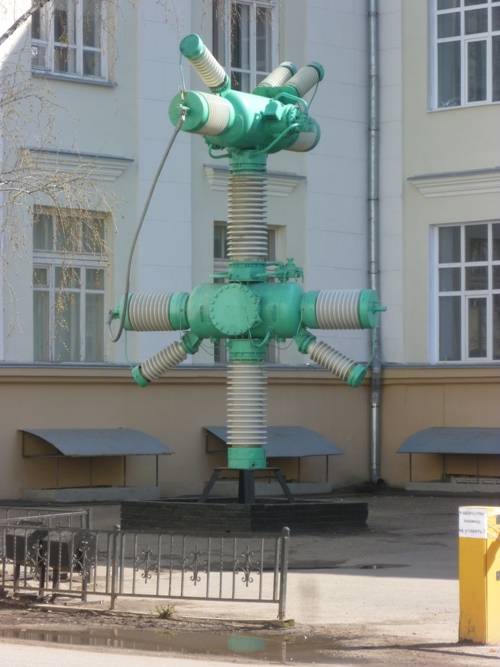
3. Памятник высоковольтному выключателю возле 8 корпуса Томского Политехнического Университета / Monument to the high-voltage switch near 8 building of Tomsk Polytechnic University
Один из множества оригинальных томских памятников установлен в 2006 году возле 8 корпуса томского политеха. Тематика выбрана неспроста, ведь в этом корпусе размещается Энергетический научно-исследовательский институт (подразделение политехнического университета).
One of the many original Tomsk monuments was set up in 2006 near eighth building of Tomsk Polytechnic University. Theme was chosen with an ulterior motive, because in this building is located Energy Research Institute (a division of Polytechnic University).
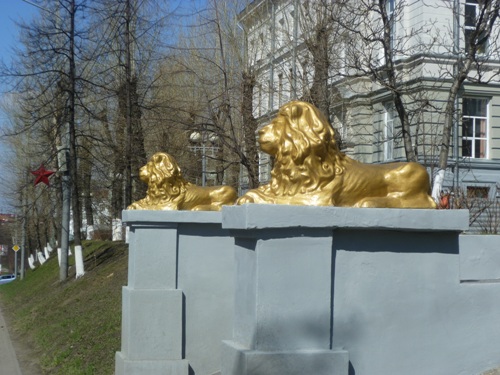
4. Эти львы охраняют подходы ко второму корпусу Томского Политехнического Университета / These lions guard the approaches to the second building of the Tomsk Polytechnic University
Львы - достаточно традиционный, но неизменно эффектный элемент городского декора. Такие бронзовые красавцы обосновались в ноябре 2009 года возле второго корпуса томского политеха, где нашёл своё пристанище химический факультет. Этот корпус был построен сразу после главного, даже раньше соседнего, "первого", корпуса.
Lions - quite traditional, but always spectacular element of urban decoration. These bronze handsome animals was appeared in November, 2009 near the second building of the Tomsk Polytechnic University, where chemical department found his refuge. This building was built immediately after the main building, even before the neighboring "first" building.
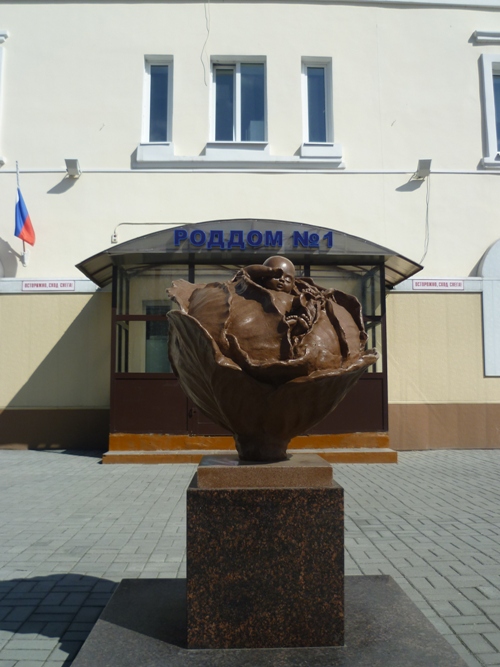
5. Памятник "Младенец в капусте" возле родильного дома №1 / Monument "The baby in a cabbage" near a maternity hospital №1
Этот памятник был открыт 15 мая 2008 года в рамках впервые проходившего в Томске празднования Дня семьи. На открытии автору композиции, скульптору Олегу Кислицкому, главным врачом первого роддома Татьяной Растохиной была выдана бирка с данными "новорождённого". Неудивительно, что этот памятник привлекает большое внимание молодожёнов и уже стал обрастать легендами и приметами.
This monument was opened on 15 May 2008 during first celebration in Tomsk of Day of the family. At the opening, the author of the composition, sculptor Oleg Kislitsky, got the tag with data of "newborn" from chief doctor of the first maternity hospital Tatiana Rastohina. Not surprisingly, this monument attracts attention of honeymooners and already has started to overgrow with legends and superstitions.

6. Памятник "Слава воину-победителю" на Новособорной площади / Monument "Glory to victorious warrior" on Novosobornaya Square
Мемориальный памятник "Слава воину-победителю" был торжественно открыт 22 июня 2011 года, в день 70-летия начала Великой Отечественной Войны. Почти двухметровая бронзовая скульптура была изготовлена по проекту художников Антона и Николая Гнедых. Место установки памятника также неслучайно - именно с Новособорной площади многие томичи отправлялись на фронт летом 1941 года.
Memorial monument "Glory to victorious warrior" was solemnly opened on June 22, 2011, the day of the 70th anniversary of the beginning of the Great Patriotic War. Almost two-meter bronze sculpture was produced by project of artists Anton Gnedykh and Nikolai Gnedykh. Location of monument installation also was chosen not accidentally - exactly from Novosobornaya Square many Tomsk citizens were leaving to the front in the summer of 1941.
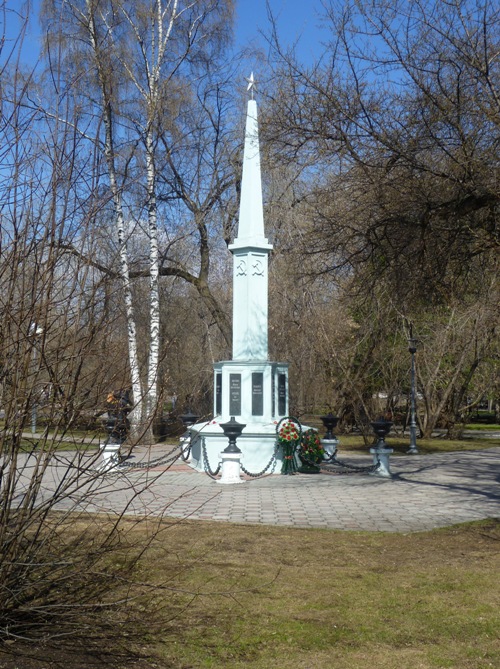
7. Стела памяти погибших в борьбе с Колчаком / Stela in the memory of those killed in the fight against Kolchak
Эта стела расположена неподалёку от братского захоронения организаторов большевистского восстания в Томске в 1919 году. На ней расположены таблички с именами видных большевистских деятелей, действовавших в Томске и уничтоженных белогвардейскими силами в 1919-1920 годах, но не попавших в число убитых в ночь с 26 на 27 марта 1919 года на татарском кладбище и позднее перезахороненных здесь же, на Новособорной площади.
This stela is located not far from brotherly burial of organizers of the bolshevik uprising in Tomsk in 1919. There are plaques on it with the names of prominent bolshevik leaders, who operated in Tomsk and were destroyed by the White Guard forces in 1919-1920, but were not included in the number of those killed in the night of 26 to 27 March 1919 at the Tatarian cemetery and later reburied here on Novosobornaya Square.
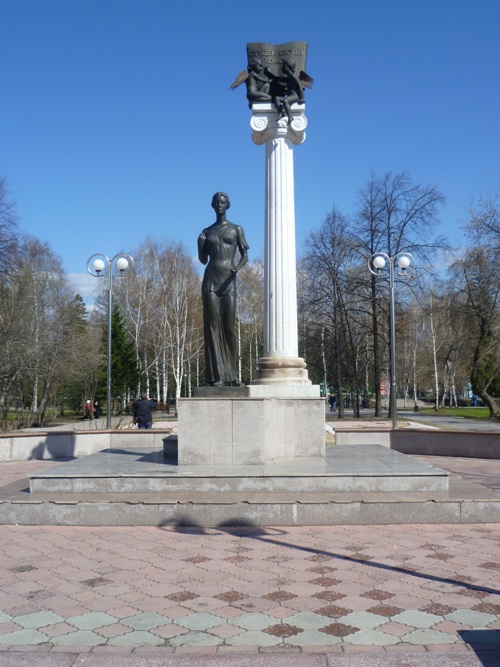
10. Памятник студенчеству на Новособорной площади / Monument to the student body at Novosobornaya Square
Общеизвестно, что Томск - город студенческий. Поэтому установка памятника студенчеству именно здесь, что называется, напрашивалась. Общая идея принадлежит спикеру областной думы Борису Мальцеву. Композиция за авторством Николая и Антона Гнедых была установлена на Новособорной площади в августе 2004 года. Предполагалось, что здесь же будет разбита Студенческая аллея, но последняя пока так и осталась лишь на бумаге. Композиция, помимо фигуры святой Татьяны - покровительницы студентов - включает также мраморную колонну, на вершине которой расположены двое ангелочков и раскрытая книга. Интересно, что крылья к ангелочкам были приделаны позже, хотя они и присутствовали в первоначальном проекте, но эта задумка не понравилась куратору проекта Борису Мальцеву. Не исключено, что на решение всё-таки добавить крылья повлияло и данное некоторыми острословами памятнику прозвище "Мать-одиночка". Некоторые студенты полагают, что посещение памятника принесёт удачу на экзаменах.
It is well known that Tomsk is a town of students. Therefore, installation of the monument to student body here suggests itself. The general idea belongs to speaker of Regional Government Boris Maltsev. The composition, authored by Nicholay and Anton Gnedykh, was set at Novosobornaya Square in August 2004. It was assumed that there also would be created the Student Alley, but the latter have so far remained on paper only. The composition, in addition to the figure of St. Tatyana - the patroness of students - also includes a marble column, on top of which there are two angels and an open book. Interestingly, the wings were attached to the angels later, although they were present in the original design, but this idea hadn't liked to the curator of the project Boris Maltsev. It is possible that on the decision to add wings had influence that fact that some wits gave to the monument nickname "single mother". Some students believe that a visit to the monument will bring good luck on exams.
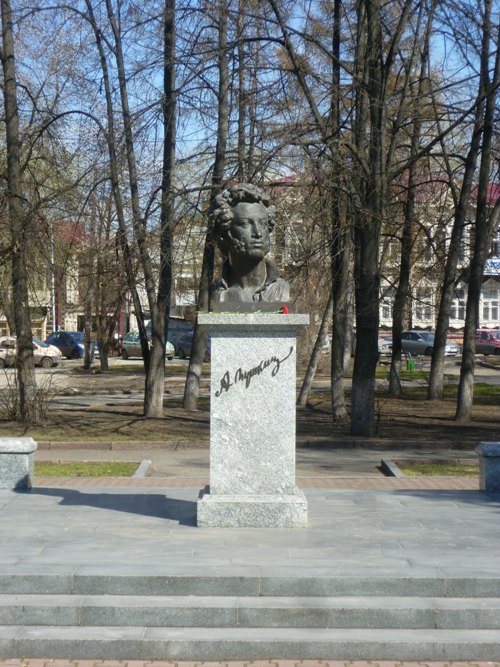
11. Памятник А.С. Пушкину возле Дворца бракосочетаний / Monument to A. S. Pushkin near the Wedding Palace
Этот памятник А.С.Пушкину был торжественно открыт 6 июня 1999 года, в день 200-летия со дня рождения поэта (в тот же день памятник поэту открывали и в Барнауле). По воспоминаниям сотрудника областной научной библиотеки имени Пушкина Эдуарда Майданюка памятник открывали с большим размахом, даже перекрыв на несколько часов проспект Ленина, одну из основных транспортных артерий города. Памятник расположился на площади между дворцом бракосочетания и краеведческим музеем. Автором скульптуры является Михаил Аникушкин.
This monument to Alexander Pushkin was opened on June 6, 1999, in the day of the 200th anniversary of the birth of the poet (the same day the monument to the poet was opened in Barnaul). According to memories of staff member of Regional Scientific Library named after Pushkin Eduard (Edward) Maydanyuk monument was opened with big way, even Lenin's Avenue, one of the main traffic arteries of the town, was closed for a few hours. The monument is located at the area between the wedding palace and local history museum. The author of the sculpture is Mikhail (Michael) Anikushkin.
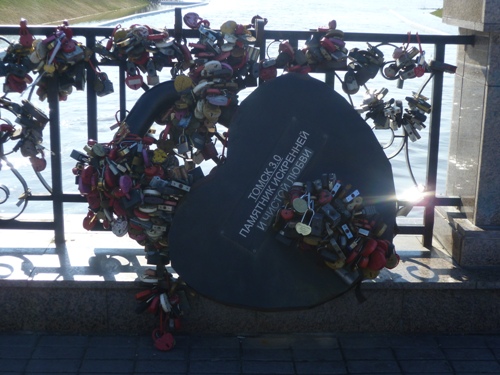
12. Памятник искренней и чистой любви возле места впадения Ушайки в Томь / Monument to sincere and pure love near the confluence Ushaika River and Tom River
Этот огромный замок в виде сердца появился на набережной Ушайки летом 2012 года. Кто был его автором, осталось неизвестным, да и вообще история появления памятника весьма туманна. Мнения горожан по его поводу также разошлись: кто-то считает его появление символичным и креативным, а кто-то напротив выражает негодование (как и вообще по поводу набравшей популярность традиции вешать на свадьбу замочки). Что касается непосредственно моего мнения, то сама идея создания подобного символа видится мне абсолютно правильной, но вот что касается исполнения, то тут я, скорее, стою на позициях противников этой новой свадебной традиции.
This huge lock in the form of heart appeared on the waterfront of Ushayka River in the summer of 2012. It is unknown who was its author and all story of the appearance of the monument is very misty. The views of townsfolk on this occasion are contradictory: some consider the appearance of the monument symbolic and creative, and someone on the contrary expresses resentment (as well as about the trending tradition to hang the wedding locks). If you ask my opinion, the idea of creating such a symbol seems to me absolutely right, but what concerns the execution, then I rather stand on the positions of the opponents of the new wedding tradition.

15. Бюст космонавта Н.Н. Рукавишникова, дважды героя Советского Союза, возле Белого озера / Bust of cosmonaut N.N. Rukavishnikov, twice Hero of the Soviet Union, near White Lake
Памятник уроженцу Томска, советскому космонавту Николаю Николаевичу Рукавишникову, был установлен 17 ноября 1978 года на берегу Белого озера. Скульптор - М. Шмаков, архитекторы - Ю. Ильин-Авдеев, Р. Кананин. На момент установки памятника Рукавишников был дважды героем Советского Союза и дважды кавалером ордена Ленина. Уже в следующем, 1979, году Николай Николаевич получил третий орден Ленина, после того, как первым в истории вручную совершил посадку корабля в аварийном режиме.
Monument to native of Tomsk, Soviet cosmonaut Nikolay Nikolaevich Rukavishnikov, was established November 17, 1978 on the shores of White Lake. Sculptor - M. Shmakov, architects - Y. Ilin-Avdeev, R. Kananin. At the time of monument's establishing, Rukavishnikov was twice Hero of the Soviet Union and twice a cavalier of the Order of Lenin. Already in the next, 1979, year Nikolay Nikolaevich was awarded by the third Order of Lenin, after the first in the history landing of the ship manually in emergency mode.
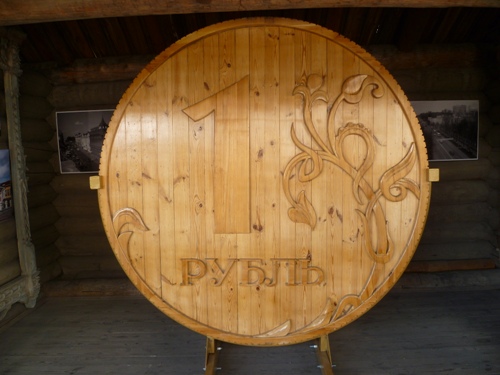
21. Памятник рублю. Деревянный "деревянный" / Monument to the ruble. Wooden "wooden"
Скульптура рубля, представляющая собой увеличенную в 100 раз деревянную копию соответствующей монеты образца 1997 года, впервые была установлена в июне 2008 года на Новособорной площади. В мае 2014 года памятник был повреждён вандалами, после чего демонтирован с целью реставрации. Весной 2015 года 250-килограммовый монумент был вновь открыт для всеобщего обозрения, но уже на территории Музея истории Томска, где, по мнению работников музея, будет находиться в большей безопасности.
Sculpture of the ruble, representing a wooden copy of the relevant coin of 1997 year, increased by 100 times, was first established in June 2008 at Novosobornaya Square. In May 2014, the monument was damaged by vandals, and then dismantled for restoration. In the spring of 2015 250-kilogrammes monument has been re-opened for public viewing, but on the territory of the Museum of the History of Tomsk, where, according to employees of the museum, it will be at more safety.
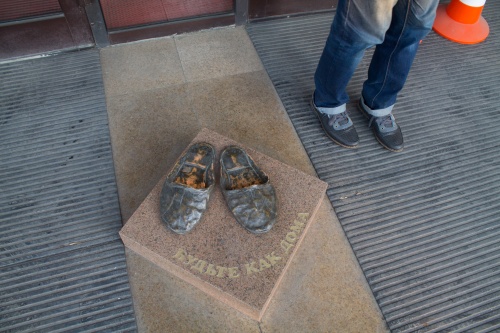
25. Памятник домашним тапочкам / Monument to house slippers
Этот оригинальный памятник за авторством известного томского скульптора Олега Кислицкого был установлен в 2006 году возле главного входа гостиницы "Томск". Он призван символизировать гостеприимство и уют. Свою идею Кислицкий предложил рассмотреть участникам проходившего в 2006 году в Томске саммита "Российской гостиничной ассоциации", которые, проникшись, даже устроили своеобразный аукцион для выбора места установки подобного символического памятника. В итоге, при непосредственном участии директора гостиницы "Томск" Михаила Кофмана, тапочки остались в Томске. Как утверждает сам автор, он долго размышлял над тем, какими именно должны быть входящие в композицию тапочки, и в итоге сделал их по слепку с собственного домашнего тапочка, посчитав, что именно такой подход наиболее полно передаёт домашнюю атмосферу.
This original monument authored by the famous Tomsk sculptor Oleg Kislitsky was installed in 2006 near the main entrance of the hotel "Tomsk". It is called to symbolize hospitality and coziness. Kislitsky suggested to consider his idea to the participants of the summit of the "Russian Hotel Association" held in Tomsk in 2006, who, being impressed, even arranged peculiar auction for choosing the place of installation of such a symbolic monument. As a result, with the direct participation of the director of the hotel "Tomsk" Mikhail Kofman, the slippers were left in Tomsk. According to the author himself, he pondered for a long time how exactly must looked like slippers included in the composition, and eventually made them on a cast from his own home slipper, believing that this is the approach that best conveys the home atmosphere.
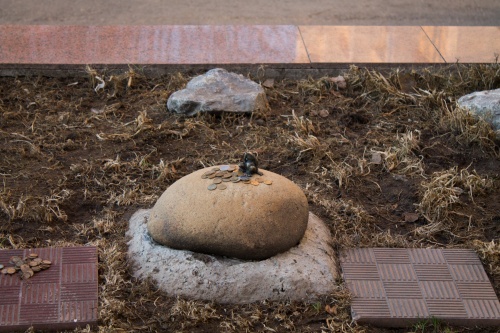
26. Памятник лягушке-путешественнице - самый маленький памятник в мире / Monument to the frog-traveller - smallest monument in the world
Рядом с гостиницей "Томск" установлен и ещё один необычный памятник. Это памятник лягушке-путешественнице, владеющий, пусть и судя по всему неофициально, титулом "самый маленький памятник в мире" (ранее пальма первенства принадлежала петербургскому Чижику-Пыжику). Памятник, автором которого опять же является Олег Кислицкий, был установлен 27 сентября 2013 года. Высота бронзовой фигурки - всего 44 миллиметра, но, судя по количеству оставляемых рядом монеток, крошка пользуется популярностью, которой могли бы позавидовать её гораздо большие собратья.
Next to the hotel "Tomsk" is installed and another unusual monument. This is a monument to the frog-traveler, which, though unofficially, owns the title of "the smallest monument in the world" (previously the palm of supremacy belonged to the St. Petersburg Chizhik-Pyzhik). The monument, authored by Oleg Kislitsky (again!), was installed on September 27, 2013. The height of the bronze figure is only 44 millimeters, but judging by the number of coins left beside frog, baby is so popular, that its much larger brethren could be envied it.
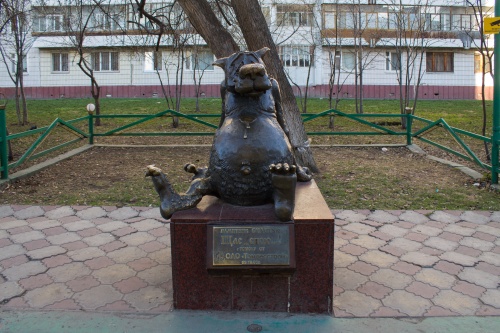
27. Памятник счастью / Monument to the happiness
Памятник счастью был установлен 5 октября 2005 года по инициативе ОАО "Томлесстрой" в качестве подарка городу в честь его 400-летия. Автором идеи называют пресс-секретаря компании Анатолия Захарова. Непосредственную работу выполняли скульптор Юлия Завьялова, литейщик Максим Петров и художник-консультант Леонтий Усов. Памятник, изображающий Волка из культового советского мультфильма "Жил-был пёс...", необычен ещё и тем, что его брюхо напичкано электроникой, и при нажатии расположенной на животе кнопки он голосом Джигарханяна произносит одну из восьми знаменитых мультцитат (например, ту самую "Щас спою..." или "Ты заходи, если что"). С прискорбием стоит отметить, что уже через месяц после установки памятника кто-то украл всю его "электронную начинку". Впрочем, благодаря усилиям местных властей, её быстро восстановили, а за памятником установили видеонаблюдение. Из-за этой характерной особенности памятника с ним связана малораспространённая байка: якобы через некоторое время после установки памятники вечерком к нему прислонился подвыпивший мужичок, а разговорчивый Волк внезапно попросил оставить ему покурить. Судя по всему, ноги этой байки растут из грандиозных (но нереализованных) планов сделать фразы Волка контекстно-интерактивными.
The monument to happiness was installed on October 5, 2005 on the initiative of OJSC "Tomlesstroy" as a gift to the town in honor of its 400th anniversary. The press secretary of company Anatoly Zakharov is called as the author of the idea. Direct work was done by sculptor Yulia Zavyalova, foundry Maxim Petrov and artist-consultant Leonty Usov. The monument depicting the Wolf from the cult Soviet cartoon "Once upon a time there was a dog ..." is unusual also because his belly is stuffed with electronics, and when the button on the stomach is pressed, he pronounces one of the eight famous citates from cartoon (for example, the same one "Right now I'll sing ..." or "You come in, in the case"). Sadly, it is need noting that one month after the installation of the monument, someone stole his entire "electronic stuffing". However, thanks to the efforts of local authorities, it was quickly restored, and video surveillance was installed behind the monument. With this characteristic feature of the monument is associated a little-spread fable: ostensibly some time after installation of the monument, in the evening, a drunk man leaned against him, and the talkative Wolf suddenly asked to leave him a cigarette. Apparently, the legs of this fable grow from grand (but unrealized) plans to make Wolf phrases contextually-interactive.
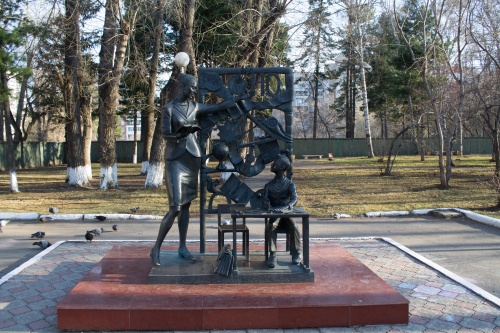
28. "Учительница первая моя..." / "My first teacher..."
Скульптурная композиция "Учительница первая моя" была установлена в Учительском сквере, рядом с главным корпусом Томского государственного педагогического университета, 5 октября 2010 года, который был объявлен в России годом учителя. Автор композиции - известный московский художник Олег Киевский, чей проект вышел победителем в борьбе с проектами 11 других скульпторов из разных городов России. Саму скульптуру отливали в Смоленске, причём, финансирование было частично обеспечено добровольными взносами горожан. Первоначально областная администрация планировала разместить композицию в Университетской роще ТГУ, однако по просьбам педагогической общественности города местом установки в итоге был выбран именно Учительский сквер.
The sculptural composition "My first teacher" was installed in the Teacher's square, next to the main building of Tomsk State Pedagogical University, on October 5, 2010, which was declared in Russia as the year of the teacher. The author of the composition is the famous Moscow artist Oleg Kievsky, whose project became the winner in the struggle against the projects of 11 other sculptors from different cities of Russia. The sculpture itself was cast in Smolensk, and the funding was partly provided by voluntary contributions from the townspeople. Initially, the regional administration planned to place the composition in the University Grove of TSU, but at the request of the pedagogical community of the town, in the end, it was the Teacher's square that was chosen as the place of installation.
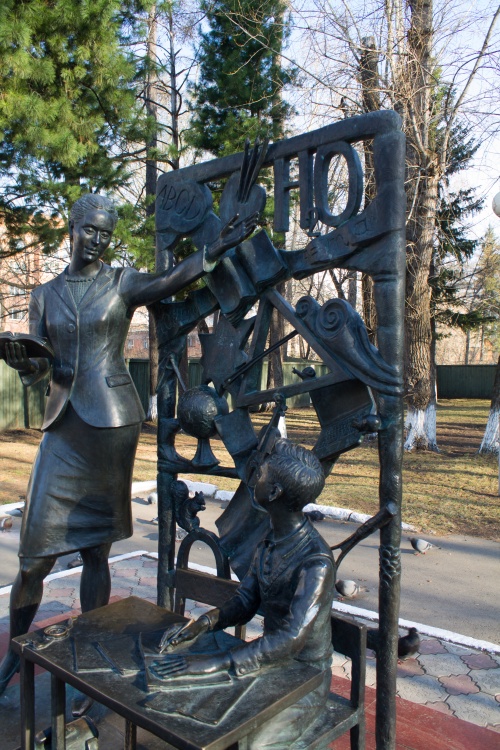
29. Учат в школе, учат в школе, учат в школе... / Studying at school, studying at school, studying at school...
Нельзя не отметить впечатляющую детализацию томского памятника учительнице и обилие различных вещей на своеобразной "доске" на заднем плане. Кажется, что здесь найдётся ассоциация для всего, что только можно встретить в школе: тут и химическая формула воды, и буквы латинского алфавита, и фамилия Пушкина, и разная живность, и глобус, и палитра с кисточками, и скрипка со смычком, и спрятавшаяся за спиной ученика теннисная ракетка, и даже ноутбук!
It is impossible not to mention the impressive detailing of the Tomsk monument to the teacher and the abundance of various things on a kind of "schoolboard" in the background. It seems that there is an association for everything that can be studying in school: here are the chemical formula of water, the letters of the Latin alphabet, the surname of Pushkin, different small animals, the globe, the palette with tassels, the violin with the bow, a tennis racket, hiding behind the pupil's back, and even a laptop!
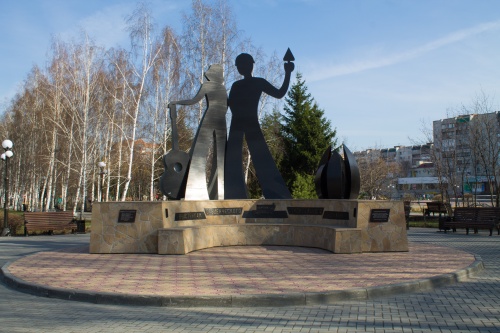
33. Памятник студенческим стройотрядам / Monument to student construction squads
В 2013 году, в 50-летнюю годовщину томских студенческих стройотрядов, был серьёзно реконструирован сквер рядом с Дворцом спорта. Венцом реконструкции стало открытие 7 сентября того же года памятника участникам стройотрядовского движения, созданного по эскизу скульптора Антона Гнедых. В основание памятника также была заложена "капсула времени" с посланием к столетию движения.
In 2013, on the 50th anniversary of the Tomsk student construction squads, the square near Sports Palace was seriously reconstructed. The crowning of the reconstruction was the opening on September 7 of the same year of a monument to the members of the construction squad movement, created according to the sketch of the sculptor Anton Gnedykh. At the base of the monument was also laid the "time capsule" with a message to the centenary of the movement.


